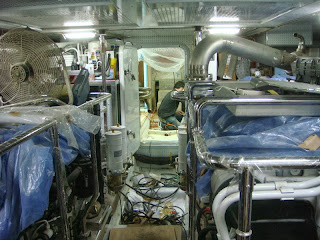Below are three photos. The first is that of a finished engine room. The second and third are of my engine room as of Week 42.
 |
| Finished engine room looking aft |
 |
| Week 42. Engine Room looking forward |
 |
| Week 42. Engine Room looking aft Newly installed Racor filter system for engine and generators |
 |
| 2. Port side forward bulkhead Fuel manifold (upper half of the box) Fuel polishing system fuel management valves |
 |
| 3. Fuel polishing system pump and filter mounted on port fuel tank Port fuel tank site glass (right side of photo) |
Explanatory Note: Filtration of fuel is a critical issue with diesel engines and the cause for most problems. Diesel fuel can contain water and dirt, which is related to timing of marina fuel deliveries or drawing fuel from the bottom of the marina's tanks. It can also contain bacteria related to sitting in the boat's fuel tanks (and, quite possibly, from marina's where they sell very little diesel). Either of these problems can cause the engine(s) to fail. The 63 is equipped to deal with these problems of three levels. These include the 20 micron Racors (second line of defense), the 2 micron on-engine fuel filters (3rd line of defense) and the fuel polishing system (first line of defense), which eliminates bacteria, dirt and water).
 |
| 4. Groco port engine sea water strainer |
Raw water enters the boat through a "through" hull fitting into the raw water or sea strainer where debris is caught in a filter. Filtered water then is pumped into the heat exchanger. The sea strainers eliminates blockage on the heat exchanger passages and prevents engine overheating.
 |
| 5. CAT C9 (503HP) Engine Heat exchanger marked "CAT Marine Power" |
This is a substantial improvement over the system in the 48 Sundancer which had a brass container. The strainer had to be opened in order to check for debris. In principle, this should have been easy. Unfortunately, Sea Ray located the strainers in a position where the sea cocks could not be easily operated and therefore the flow of water could not be shut off. When the strainer was opened sea water flowed into the boat. Checking the filter basket was a nightmare.
 |
| 7. Close up of raw water pumps for the Cruisair Chilled Water HAVC System The second pump is installed as a back-up |
 |
| 8. ABT TRAC raw water pump for hydraulic system cooling mounted forward of the starboard engine |
 |
| 9. Port engine power take-off hydraulic system pump Powers the hydraulic system including thrusters, stabilizers and windlass |
 |
| 10. ABT TRACK Stabilizer Actuator located forward of the engine room. Note: The stabilizer actuator in accessed through handing lockers on the aft bulkhead in the master stateroom |
 |
| 11. Cruisair Chilled Water HAVC System |
The condenser and compressor for the chilled water (aka "tempered water") system is located in the engine room thus greatly reducing noise (especially in the 63 where the engine room is heavily insulated). The chilled or heated fresh water is then pumped through an insulated piping loop to air handlers which are located in the living spaces (salon, galley, pilothouse, VIP SR, guest SR and master SR). The engine room components are readily serviceable.
 |
| 12. Starboard engine exhaust leading to mufflers installed in the lazarette Charles ISO Boost Transformers and breaker boxes (to the left of the worker) |
 |
| 13. Engine starting battery (port side) Hydraulic pump in the foreground |
 |
| 14. Cruisair Chilled Water HVAC System controls mounted in the lazarette |
 |
| 15. Combination battery charger/inverter for the house batteries |
 |
| 16. House battery banks located in the lazarette Cruisair Chilled Water System control boxes (on bulkhead) |
 |
| 17. Port aft bulkhead (close to catwalk) Battery switches Generator controls with engine gauges Generator breaker box (top of photo) |
 |
| 18. Port aft bulkhead (closest to hull) 12KW generator, muffler left rear, and 24 volt charger for engine starting batteries |
 |
| 19. Fresh water pumps located on top of the 300 gallon water tank |
 |
| 20. Gray water sump (1 of 2) |
 |
| 21. Black water (holding) tank |
I hope you enjoyed this article.
Written by Les.


Thank you very much for this great post.
ReplyDeletevalve manufacturer